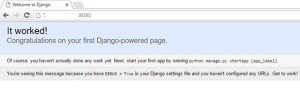Django is a popular Python framework for writing web applications. Web frameworks like Django provide a set of tools which helps the developer to write the application faster as the framework takes care of the internal structure, thus the developer needs to take care of the application development only. Django is free and open source software.
This article assumes you have at least basic knowledge of Linux, know how to use the shell, and most importantly, you host your site on your own VPS. The installation is quite simple and assumes you are running in the root account, if not you may need to add ‘sudo’ to the commands to get root privileges. I will show you through the step by step installation Django on an Ubuntu 18.04 (Bionic Beaver) server.
Install Django on Ubuntu 18.04
Step 1. First, make sure that all your system packages are up-to-date
sudo apt-get update sudo apt-get upgrade
Step 2. Installing Python 3 and venv.
Now you can install pip using the following command:
sudo apt install python3-venv
Next, Creating Virtual Environment:
mkdir my_django_app cd my_django_app
Once inside the directory, run the following command to create your new virtual environment:
python3 -m venv venv
To start using this virtual environment, you need to activate it by running the activate script:
source venv/bin/activate
Step 4. Installing Djanggo with pip install
Once the pip is installed, run the following command to install Django:
sudo pip install django
To verify the Django version, run:
python -m django --version
Step 5. Create a sample Django project.
Now that the Django framework has been installed, you can to give it a test drive by creating a sample project:
cd ~ django-admin startproject mysite
The command above will create a directory myproject in your working directory ~, and store all necessary files within.
Run the commands below in sequence to get your application started. Follow the instructions on screen to provide the superuser’s credentials:
cd myidproject/ python3 manage.py migrate python3 manage.py createsuperuser python3 manage.py runserver
Step 6. Accessing Django.
Django will be available on HTTP port 8080 by default. Open your favorite browser and navigate to http://yourdomain.com:8000 or http://server-ip:8000/admin

Congratulation’s! You have successfully installed Django. Thanks for using this tutorial for installing Django web framework on Ubuntu 18.04 Bionic Beaver server. For additional help or useful information, we recommend you to check the official Django web site.








